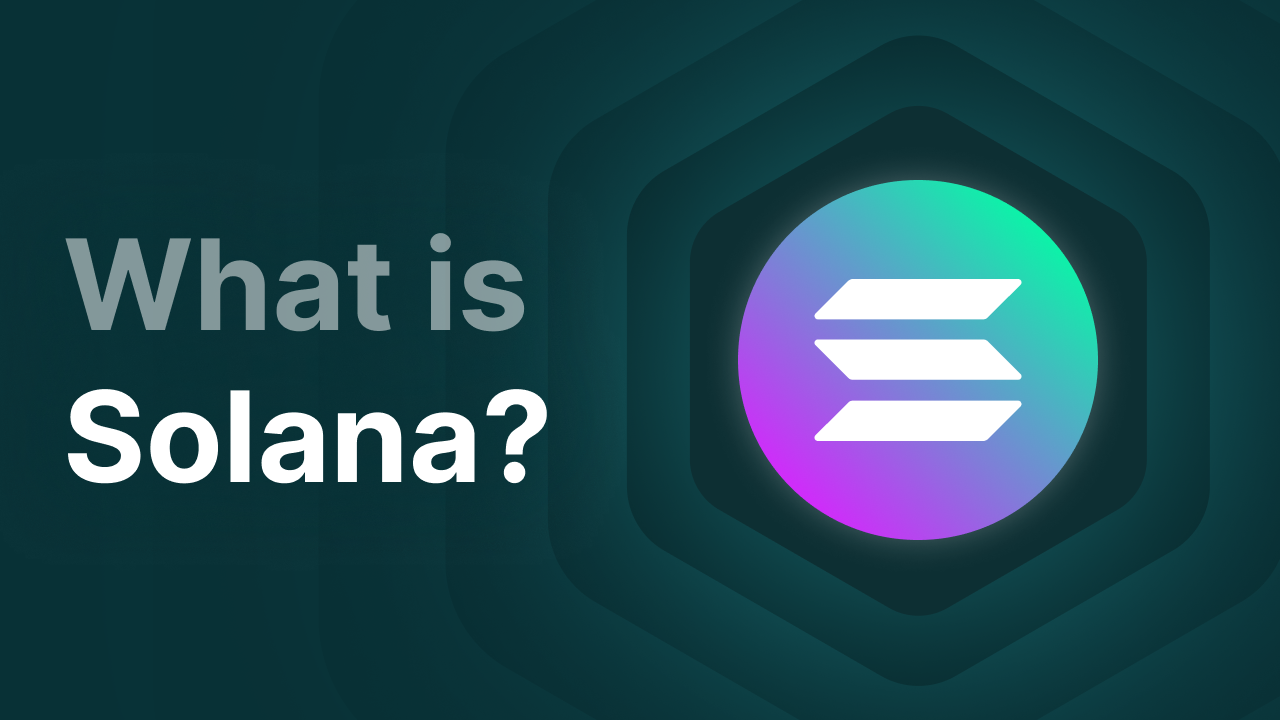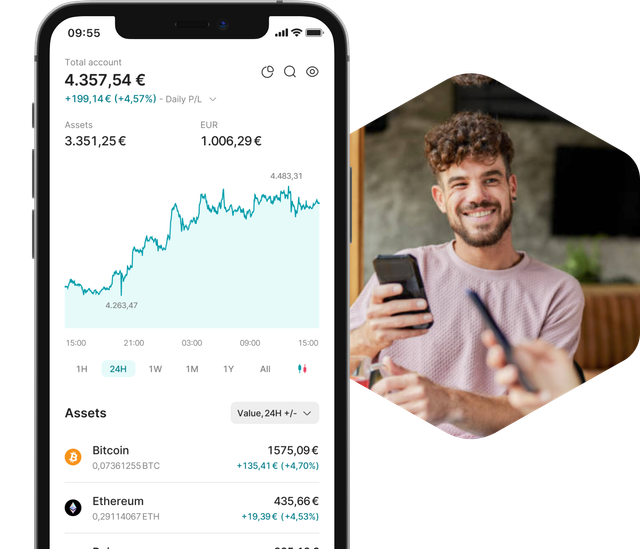What is Solana (SOL)?

Founded back in 2017, Solana (SOL) is a blockchain platform that is built to host decentralized, scalable applications. The Solana Foundation based in Zug, Switzerland runs the open-source project and is dedicated to the decentralization, adoption, and security of the Solana ecosystem. However, the blockchain itself was built by the San Francisco-based Solana Labs.
Key Takeaways
- Solana (SOL) is a blockchain platform that is built to host decentralized, scalable applications.
- Key advantages of Solana are the speed at which it can process transactions and its very low transaction fees in comparison to rival blockchains such as Ethereum.
- Solana is currently the fifth most popular cryptocurrency with a market cap of more than €63 billion. The current circulating supply of SOL is over 462,78 million coins. Data is taken from the 2nd of July 2024.
- Proof-of-History (PoH) enables the blockchain to achieve consensus by confirming the passage of time between events and incorporating this time progression into the ledger. PoH allows for a more efficient and faster consensus mechanism.
- The current Solana price is...
Key advantages of Solana are the speed at which it can process transactions and its very low transaction fees in comparison to rival blockchains such as Ethereum.
Solana is currently the fifth most popular cryptocurrency with a market cap of more than €63 billion. The current circulating supply of SOL is over 462,78 million coins. Data is taken from the 2nd of July 2024.
Now that we’ve had a brief introduction to Solana, let’s continue with our comprehensive guide by exploring its history.
History of Solana
Solana was founded by Anatoly Yakovenko in 2017. Yakovenko, a former Qualcomm engineer, aimed to create a blockchain that could scale to accommodate the growing demands of the global financial system. Together with Greg Fitzgerald and Eric Williams, Yakovenko launched the Solana protocol and its native token, SOL, in March 2020.
Yakovenko hypothesized that employing proof-of-history could significantly accelerate blockchain performance compared to clockless systems like Bitcoin and Ethereum. These traditional systems have difficulty scaling beyond 15 transactions per second (TPS) globally, far less than centralized payment systems like Visa (V), which can handle up to 65,000 TPS at peak times.
Yakovenko's proof-of-history overcomes this limitation by allowing every node in the network to depend on the documented passage of time.
How Solana Works and the Proof-of-History Concept
Solana employs a unique combination of technologies to achieve its high transaction speeds and scalability. The most notable of these technologies include:
- Proof-of-History (PoH): In November 2017, Yakovenko released a white paper detailing the Proof-of-History (PoH) concept. PoH enables the blockchain to achieve consensus by confirming the passage of time between events and incorporating this time progression into the ledger. PoH allows for a more efficient and faster consensus mechanism.
- Tower BFT (Byzantine Fault Tolerance): This is Solana's version of a consensus algorithm, which works in conjunction with PoH to secure the network and validate transactions.
- Gulf Stream: This protocol pushes transaction caching and forwarding to the edge of the network, allowing for fast confirmation times and reducing memory pressure on validators.
- Sealevel: This is a parallel smart contracts runtime that optimizes resource usage and allows Solana to run thousands of smart contracts simultaneously.
- Pipelining: A process that assigns different stages of transaction validation to different hardware units, further increasing throughput.
- Cloudbreak: A horizontally scalable state architecture that ensures the network can handle a large number of transactions.
In theory, Solana’s architecture can support up to 710,000 TPS on a standard gigabit network and as many as 28.4 million TPS on a 40 gigabit network.
Key Features of Solana
Solana's technology stack brings several key features that distinguish it from other blockchain platforms:
- High Throughput: Solana's architecture allows for a high throughput of transactions, making it one of the fastest blockchains in the world.
- Low Fees: The efficient transaction processing means lower fees for users and developers.
- Scalability: Solana's ability to handle a large number of transactions without compromising speed or cost makes it highly scalable.
- Decentralization: Despite its high performance, Solana maintains a decentralized network of validators.
- Robust Ecosystem: Solana supports a wide range of dApps, DeFi projects, and NFTs, making it a versatile platform for developers.
Solana's Ecosystem
The Solana ecosystem has grown rapidly, encompassing a diverse range of applications and projects:
- DeFi Projects: Solana hosts numerous decentralized finance (DeFi) applications, including lending platforms, decentralized exchanges (DEXs), and stablecoins. Projects like Serum, Raydium, and Mango Markets have become integral parts of the Solana DeFi landscape.
- NFTs: Solana has also made significant strides in the non-fungible token (NFT) space. With platforms like Solanart, DigitalEyes, and Metaplex, Solana offers a thriving marketplace for digital art and collectibles.
- Gaming: The gaming industry is leveraging Solana's speed and scalability to create immersive experiences. Projects like Star Atlas and Aurory are leading the way in blockchain-based gaming on Solana.
- Web3: Solana supports various Web3 applications, including decentralized social media platforms and DAOs (Decentralized Autonomous Organizations).
Solana Price Analysis
The price of Solana (SOL) has experienced significant volatility, reflecting broader trends in the cryptocurrency market. Since its launch, SOL has seen substantial growth, becoming one of the top cryptocurrencies by market capitalization. Several factors influence the price of SOL, including:
- Market Sentiment: Like all cryptocurrencies, Solana's price is affected by overall market sentiment and investor confidence.
- Adoption and Usage: Increased adoption of the Solana platform by developers and users can drive demand for SOL.
- Technological Advancements: Updates and improvements to the Solana network can positively impact the price.
- Competition: The performance of competing blockchain platforms can influence Solana's market position.
As of now, Solana continues to attract significant interest from investors and developers, contributing to its dynamic price movements.
Solana News
Staying up to date with the cryptocurrencies you invest in and/or are interested in is a crucial part of improving your investment strategy.
That being said, let’s take a look at some of the most recent Solana news that’s got the community excited.
VanEck, a trailblazer in issuing Bitcoin ETFs, has recently filed for a spot Solana exchange-traded fund (ETF) which resulted in Solana (SOL) experiencing a ~12% price increase. The potential approval of a spot Solana ETF in the U.S. has increased investor optimism, indicating a growing acceptance of Solana in traditional financial markets. If approved, VanEck’s ETF would enable investors to gain exposure to SOL without directly buying the cryptocurrency, potentially boosting institutional interest and adoption and leading to renewed interest and substantial price increases for the asset.
An analyst from Bitget suggests that SOL could become the third major cryptocurrency after BTC and ETH if it gets its own ETF, owing to its recent growth.
How to Buy Solana
Step 1: Choose your Exchange
Before you buy Solana (SOL), we recommend researching crypto exchanges and choosing the most reliable one. Look for platforms that have a user-friendly interface, strong security, and a broad range of cryptocurrencies. With Finst you can trade over 340 cryptocurrencies in EUR, with maximum safety and transparency.
It is also important to consider the fees that you incur while trading crypto. Using Finst, you will encounter the lowest trading fees in the Netherlands without any hidden costs. A flat fee of 0,15% per trade. That’s it.
You save an average of 83% on your trading fees. But don’t take our word for it, check out the comparison chart on our fees page.
Step 2: Create your Account
Once you've chosen an exchange, the next step is to create an account. You can open an account online with Finst without any costs. Opening an account only takes 5 minutes, click here to get started.
Step 3: Deposit EUR
After successfully creating your account, you can make your first EUR deposit. Finst currently supports instant payment methods such as iDEAL, Bancontact, and SEPA bank transfers.
Simply deposit funds to your account by clicking on the “Deposit/Withdrawal” button located on the trading platform and follow the instructions. You can also Deposit funds via bank transfer in EUR with the unique payment description in your account. At Finst depositing and withdrawing funds is always free without any minimum amount.
Need some more guidance on how to deposit EUR with Finst? We’ve got you covered, check out the video tutorial below.
Step 4: Buy Solana (SOL)
With EUR in your account, it's time to buy Solana (SOL). Use the search function on the platform to find SOL. If you're new to the world of crypto, consider starting with well-known cryptocurrencies like Bitcoin (BTC), Ethereum (ETH), or in this case Solana.
Step 5: Place your Order
Decide on the amount of EUR you want to invest or the quantity of SOL you want to buy and place an order on the platform. You’re all set. Congratulations on your trade!
To see a tutorial on how to buy Solana with Finst, click on the video below.
The Future of Solana
Solana's future looks promising, given its technological advancements and growing ecosystem. Here are some factors that could shape its trajectory:
- Scalability Solutions: Solana's ability to scale efficiently will be crucial as more projects and users join the network.
- Adoption by Institutions: Institutional interest and investment can drive Solana's growth and legitimacy in the financial world. If the spot Solana ETF is approved, this will likely have a positive impact on SOL’s adoption.
- Development of dApps: The success and innovation of decentralized applications built on Solana will play a significant role in its adoption.
- Community and Governance: A strong, engaged community and effective governance model will be essential for Solana's long-term success.
- Regulatory Environment: The evolving regulatory landscape for cryptocurrencies will impact Solana's development and adoption.
Conclusion
Solana (SOL) stands out as a high-performance blockchain platform with the potential to revolutionize the cryptocurrency space. Its innovative technology, robust ecosystem, and growing adoption make it a significant player in the market. Whether you're an investor, developer, or enthusiast, understanding Solana and staying updated with the latest developments can provide valuable insights into this dynamic and rapidly evolving platform.
As with any investment, it's crucial to conduct thorough research and consider the risks involved. Solana's journey is just beginning, and its future holds exciting possibilities for the world of decentralized finance and beyond.
